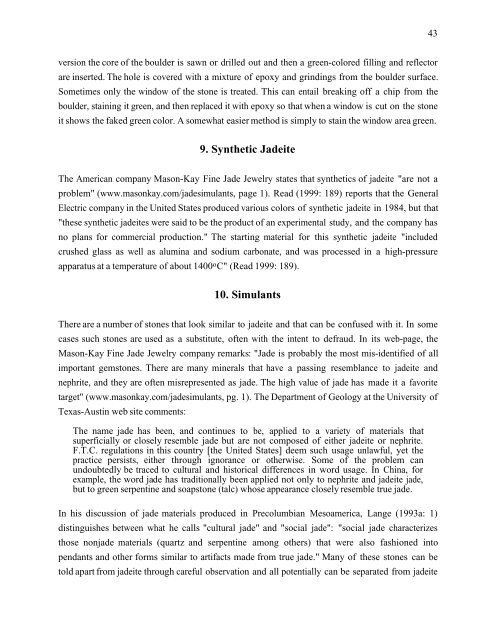JADEITE - Canadian Institute of Gemmology
JADEITE - Canadian Institute of Gemmology
JADEITE - Canadian Institute of Gemmology
You also want an ePaper? Increase the reach of your titles
YUMPU automatically turns print PDFs into web optimized ePapers that Google loves.
version the core <strong>of</strong> the boulder is sawn or drilled out and then a green-colored filling and reflector<br />
are inserted. The hole is covered with a mixture <strong>of</strong> epoxy and grindings from the boulder surface.<br />
Sometimes only the window <strong>of</strong> the stone is treated. This can entail breaking <strong>of</strong>f a chip from the<br />
boulder, staining it green, and then replaced it with epoxy so that when a window is cut on the stone<br />
it shows the faked green color. A somewhat easier method is simply to stain the window area green.<br />
9. Synthetic Jadeite<br />
The American company Mason-Kay Fine Jade Jewelry states that synthetics <strong>of</strong> jadeite "are not a<br />
problem" (www.masonkay.com/jadesimulants, page 1). Read (1999: 189) reports that the General<br />
Electric company in the United States produced various colors <strong>of</strong> synthetic jadeite in 1984, but that<br />
"these synthetic jadeites were said to be the product <strong>of</strong> an experimental study, and the company has<br />
no plans for commercial production." The starting material for this synthetic jadeite "included<br />
crushed glass as well as alumina and sodium carbonate, and was processed in a high-pressure<br />
apparatus at a temperature <strong>of</strong> about 1400 o C" (Read 1999: 189).<br />
10. Simulants<br />
There are a number <strong>of</strong> stones that look similar to jadeite and that can be confused with it. In some<br />
cases such stones are used as a substitute, <strong>of</strong>ten with the intent to defraud. In its web-page, the<br />
Mason-Kay Fine Jade Jewelry company remarks: "Jade is probably the most mis-identified <strong>of</strong> all<br />
important gemstones. There are many minerals that have a passing resemblance to jadeite and<br />
nephrite, and they are <strong>of</strong>ten misrepresented as jade. The high value <strong>of</strong> jade has made it a favorite<br />
target" (www.masonkay.com/jadesimulants, pg. 1). The Department <strong>of</strong> Geology at the University <strong>of</strong><br />
Texas-Austin web site comments:<br />
The name jade has been, and continues to be, applied to a variety <strong>of</strong> materials that<br />
superficially or closely resemble jade but are not composed <strong>of</strong> either jadeite or nephrite.<br />
F.T.C. regulations in this country [the United States] deem such usage unlawful, yet the<br />
practice persists, either through ignorance or otherwise. Some <strong>of</strong> the problem can<br />
undoubtedly be traced to cultural and historical differences in word usage. In China, for<br />
example, the word jade has traditionally been applied not only to nephrite and jadeite jade,<br />
but to green serpentine and soapstone (talc) whose appearance closely resemble true jade.<br />
In his discussion <strong>of</strong> jade materials produced in Precolumbian Mesoamerica, Lange (1993a: 1)<br />
distinguishes between what he calls "cultural jade" and "social jade": "social jade characterizes<br />
those nonjade materials (quartz and serpentine among others) that were also fashioned into<br />
pendants and other forms similar to artifacts made from true jade." Many <strong>of</strong> these stones can be<br />
told apart from jadeite through careful observation and all potentially can be separated from jadeite<br />
43









